
views
Treating Pain With Medicine
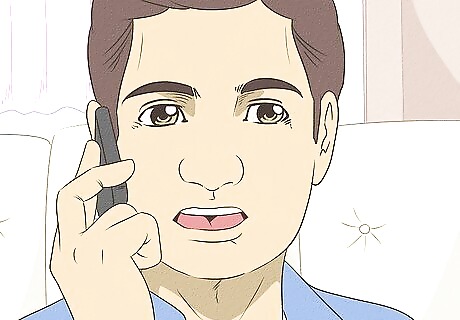
Call the vet and give your horse first aid as soon as you notice founder. Founder can come on suddenly, and is a serious medical condition, so make sure to call the vet and administer first aid to manage your horse's pain. While you are waiting for the vet to arrive, encourage the horse to walk on soft ground. Gentle walking helps blood to circulate in the hooves and can relieve some of the pain by removing inflammatory toxins from the hoof. If the horse refuses to move, she may well be in so much pain that she can't, so leave her alone.
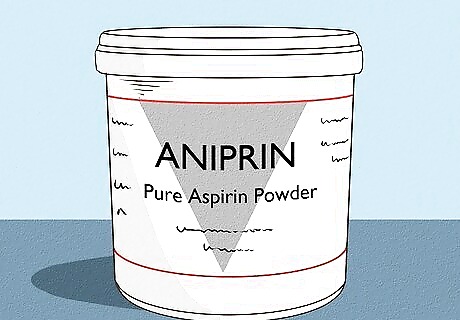
Administer AniPrin in order to manage pain immediately. If you have access to equine aspirin, then give a dose to your horse as a first aid measure while you wait for professional help. Some types of aspirin (acetylsalicylic acid) are available over the counter from pharmacies, making them a useful first aid treatment. Always make sure your horse has access to a plentiful supply of fresh water, to help with the digestion and absorption of aspirin. Never give aspirin to a horse that is taking other medications without first consulting your vet. AniPrin contains powdered acetylsalicylic acid mixed in a palatable molasses flavor base, designed to be mixed in feed. The dose is 10mg/kg once daily. For a 500kg horse this equates to 5,000mg (or 5 grams) of AniPrin. Two scoops are supplied with the product: the larger measures out 28.35grams, and the smaller 3.75grams. Thus, a typical 500kg horse requires 1.5 small scoops of AniPrin once daily on food.
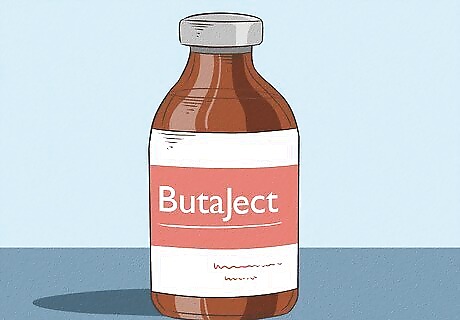
Treat your horse with equine NSAIDs to manage long-term pain. A full recovery from a serious flare up can take 6-12 months, and especially during the first few weeks good pain relief is essential for the animal's welfare. Over the longer term, effective pain relief involves drugs from the non-steroidal anti-inflammatory (NSAIDs) family, of which aspirin is a member. No one drug is superior to any other, and it is largely a matter of which medication best suits a particular horse. What works well for one horse may not help another, so if you horse remains in pain despite using a certain drug, the vet may suggest switching meds. NSAIDs work by inhibiting the release of prostaglandins that cause inflammation and pain. Never give NSAIDs on an empty stomach, to avoid liver and stomach damage. Never give NSAIDs to a dehydrated animal because this could concentrate the drug and amplify its damaging effects on the kidney. If your horse exhibits loss of appetite and increased thirst, this could be an indicator of NSAID side effects. Stop administering NSAID medications and contact your vet to seek further medical treatment.
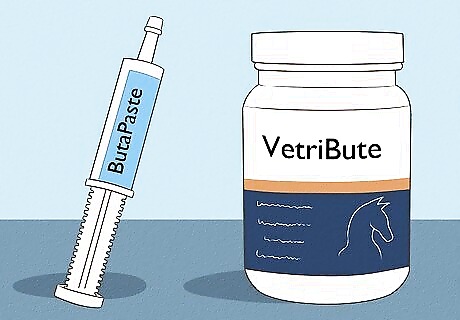
Try using phenylbutazone to manage severe pain. Commonly known as "bute" amongst horse owners, phenylbutazone reduces pain and fever. Phenylbutazone is a prescription NSAID and needs to be prescribed by your vet. It should not be used in combination with other NSAIDs, steroids, or given on an empty stomach. A typical equine preparation is Butazolidin. The dose for a 454kg horse is 2-4 grams once a day with or after food. It is available as 1 gram tablets, an oral paste, or an oral powder containing 1 gram of phenylbutazone in a 10 gram sachet. The manufacturer advises that you don't exceed 4 grams a day, and if possible administer the lowest effective dose.
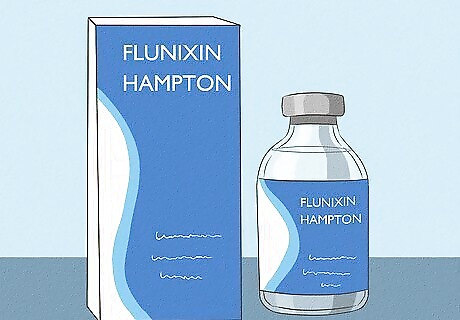
Use flunixin to manage pain if other NSAIDs don't manage pain effectively. Flunixin is another prescription NSAID and a typical equine formulation is Banamine. The mode of action is similar to other NSAIDs in that it inhibits prostaglandin, and therefore inflammation and pain. It is rapidly absorbed by the stomach and small intestine, and each dose works for 24-30 hours. The dose of Banamin is 1.1mg/kg once daily by mouth. A 500kg horse requires 550 mg (0.5gram) which is equivalent to one 20 gram sachet containing 500mg of flunixin. Flunixin has been show to block some of the effects of endotoxins (natural toxins produced as a result of inflammation) released during the inflammatory process of laminitis. In severe cases of founder, many veterinarians use flunixin as their first choice treatment because of this additional effect.
Helping Your Horse Recover
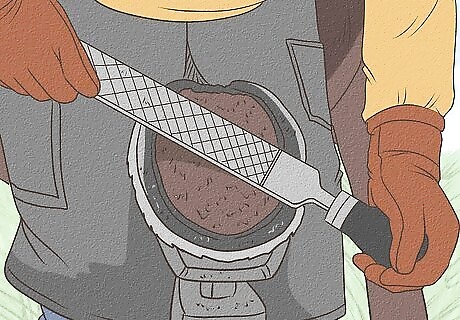
Trim your horse's hooves to relieve pressure on the lamina. Founder is a complex condition and weakens the support for the bones inside the hoof, so making sure the hoof strikes evenly is essential to prevent further damage. Much like a broken fingernail, full repair does not happen until the damaged part of the hoof has fully grown out which takes 6-12 months. During this time, the angles of force on the hoof changes (because of the lack of support from the laminae) and the hoof grows unevenly. Therefore, trimming the hoof to maintain a good upright posture is critical both in the short term (to relieve pressure) and long term (for a smooth gait). Left untrimmed, the eventual result is an Aladdin's slipper type hoof with a long slopping toe and short heels, which will predispose your horse to lameness. You must ensure careful trimming and shortening of the toe every 2-4 weeks. Ask your farrier to give your horse corrective hoof trimming and realignment trimming. Corrective hoof trimming will restore proper hoof form and function. Corrective trimming will allow the hooves to be healthy again. Realignment trimming trims back the toe so that it is in line with the coffin bone. Realigning trimming pushes the coffin bone back into the correct position. The process of a new hoof capsule totally growing out to replace the old one takes up to a year. You must leave your horse on laminitis trimmings long term. This will prevent the laminitis from coming back. The trimmings will reverse laminitis.

Remove the horse's shoes to reduce inflammation. Ideally, a horse with founder has his shoes removed. This spares the horse the weight and concussion of its shoes hitting the ground with each step. Removal also allows the hoof wall to expand with the inflammation, rather than being constricted. However, it is important to make sure that the sole is concave in relation to the ground, so that the sole stays raised above the ground. If the sole has dropped, then shoes (or pads) are necessary to prevent the horse wearing through the sole and exposing its foot bone.
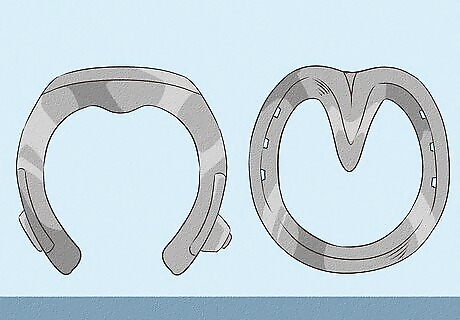
Use orthopedic horse shoes to protect the hoof. If the horn of the hoof wall is brittle and crumbly, then it is likely to chip away and cause more pain. In addition, a poor quality hoof wall is more frequently associated with a dropped sole (the sole loses its concave arch and sits in contact with the ground). In these circumstances, orthopedic horse shoes may be necessary to keep the hoof wall intact, lift the sole, and keep the angle of the toe bones as close to their normal anatomical position as possible. Some common types of shoes are: Reversed shoes. The feet are trimmed to reduce the length of the toe (to prevent the hoof being tipped backwards) and a regular shoe is put on back-to-front. The aim is to raise the heel and drop the toe to help realign the toe bones with the hoof wall. Egg bar shoes. Instead of having an open back like a traditional horseshoe, egg bar shoes form a complete oval. Again, the idea is to provide support to the heel by raising it slightly and taking pressure off the back of the foot. Heart bar shoes. These are a complete shoe, lacking the traditional gap, but have a "V" shaped metal insert (hence the "heart") that covers the frog. This helps to protect the painful part of the foot from contact with the ground and raises the heel to help restore the correct alignment of the pedal bone with the floor.
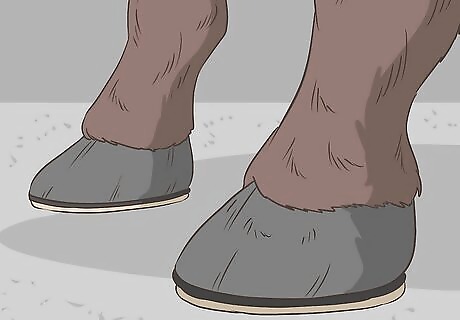
Attach pads to support and cushion the sole. Helping the horse feel comfortable enough to move around will aid his recovery. One way to do this is to attach pads to the bottom of his hooves to provide cushioning for the painful sole. There are many different commercial varieties of pads available, of which Styrofoam pads are one example that can adapt to the shape of the individual hoof. These are 2-inch deep pads of special foam. They come in three hoof sizes, small, medium, and large. They are attached to the bottom of clean hooves and kept in place with gaffer tape and bandages. The horse's weight crushes and molds the pads, providing cushioning where it is most needed. After two days, the pads will have compressed to a half-inch of thickness, at which point a new layer should be added for extra comfort. This is often enough to enable the horse to walk at a slow pace, which increases the blood flow to the hoof and aids recovery. Pads should be changed when they become totally compressed and may be needed every 2 weeks, depending on the severity of the disease. Once the initial pain has subsided, the pads can be removed and the hoof trimmed as discussed below.
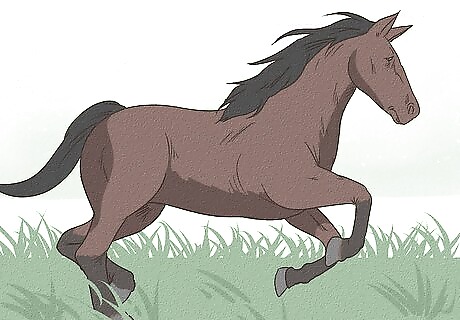
Allow your horse to exercise to promote blood circulation. Wild horses recover by keeping moving with the herd, which promotes blood circulation in the hoof and helps remove toxins. You can turn horses with mild laminitis out onto soft pasture with other animals to encourage them to keep moving. The pasture must not contain lush rich grass as this can further inflame laminitis, so if suitable land is not available the horse should be stabled on soft bedding and taken for short walks every 3- 4 hours. When walking a horse with laminitis, take it at a gentle pace and walk in straight lines, avoiding lunging or tight corners. This is because the support for the bone inside the hoof is weak and any undue force could sheer the tendon completely. The best surface to walk on is firm ground with a slight give, such as packed dirt. Avoid surfaces such as sand, that shift and press into the sole. If suitable ground is not available, you can bring your horse out on pavement with the horse wearing pads.
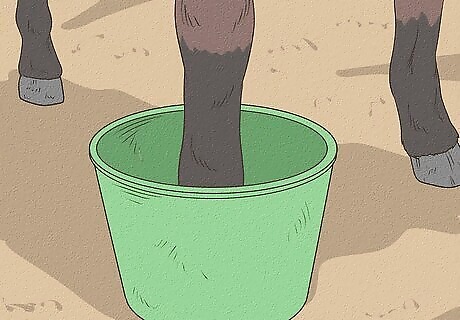
Relieve abscesses to promote healing and reduce pain. Sterile abscesses can develop inside the hoof as a result of white blood cells brought in to reduce inflammation. However, the resulting pressure build up needs to be relieved. You can use poultices with Animalintex, or soak the hoof in a bucket of warm water with a cup of cider vinegar to help soften the horn and allow the discharge to find a route out, thus relieving the pressure.

Feed your horse a diet low in simple sugars to reduce inflammation. For some animals there is a link between diet and episodes of laminitis. During recovery, keep a close eye on your horse's diet. Simple sugars increase the level of insulin, which in some horses triggers laminitis. It helps to maintain a diet low in simple sugars. Foods that fit this description are mature grasses and hay made from mature flowering grasses. If you are feeding your horse hay, soaking it for a couple of hours before feeding can leech out some sugars and make it moist so there is less risk of impaction colic. Avoid feeding your horse grains and lush grass. If it ever gets to a point where your horse can't stand up, or if the coffin bone drops through the sole of the hoof, you may need to put your horse down.




















Comments
0 comment